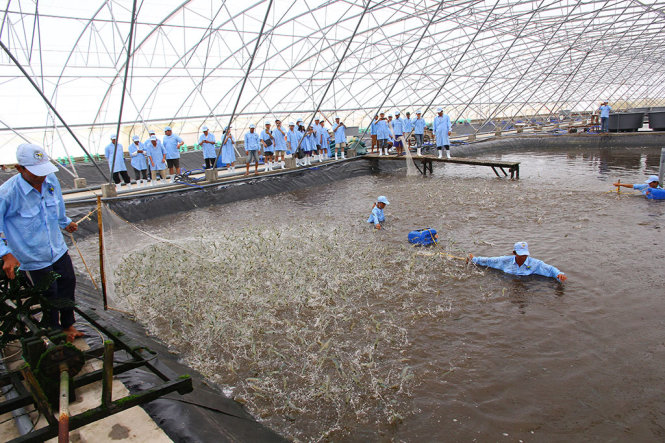ELIMINATING THE USE OF ANTIBIOTICS IN THE AQUACULTURE
17/04/2017
________________________________________
Eliminating the use of antibiotics in the aquaculture
Most producers would agree that the use of antibiotics is something they would like to avoid, however the barriers for antibiotics must be more stringent.

Shrimp farming in hi-tech, antibiotic-free housing is a model that is being replicated in Bac Lieu – Picture: Chí Quốc
From the enterprises persective, the source and origin of this antibiotic needs to be eliminated from the import and the feed manufactures in order to provide antibiotic free shrimps.
Getting used to not using antibiotics
Over the past four years, all members of the cooperative of agriculture and fishery 14/10 (My Xuyen district, Soc Trang province) have achieved very high productivity thanks to the application of clean shrimp farming, not using antibiotics an other prohibited substances.
One of the secrets to ensure the shrimps not getting disease without using antibiotics, according to Mr. Ngo Cong Luan – director of the cooperative, is low density shrimp farming combined with tilapia culturing. “Tilapia cultured in ponds will filter bacteria, create algae, which is very suitable for shrimp farming,” Luan said.
In fact, according to Mr. Luan, the abuse of chemicals and antibiotics in shrimp farming is a double-edged sword, with few successful cases but leaving negative consequences as the result. “Saying no to antibiotics and farming clean shrimp will in return protect ourselves by reducing costs and stability,” Luan said.
With this farming model, the efficiency of the cooperative is increasing, reaching an average profit of 1.2-4.4 VND billion per year in the period 2013-2016, and getting more orders from supermarkets, and enterprises.
Mr. Duong Van Kiet (Hoa Dien commune, Kien Luong district, Kien Giang province) said that many farmers in the area are also ecological shrimp farming, combining organic rice cultivation with shrimp farming. After harvesting the rice, the stems are retained and the water is added into the field in order to form shrimp feed. “If you use chemicals, the shrimps canl not survive,” Mr. Kiet said.
Eliminating antibiotics from the roots.
Mr. Nguyen Van Dao, General Director of Go Dang Company (My Tho Industrial Zone, Tien Giang), said that most seafood exporters have not used antibiotics in farming areas for many years. Because once importers detect residues of antibiotics, the enterprise will face with losing customers.However, some traders have renamed or mixed antibiotics with other products so that to bypass the relevant agency and the farmers.
According to Duong Ngoc Minh, Chairman of Hung Vuong Joint Stock Company, 99.99% of exported pangasius from Vietnam is strictly controlled of antibiotic residue, because the importers always require samples before entering the contract. “The antibiotic test is quite simple, safe and does not take much time so almost any large export enterprises have laboratories, and small businesses just need to prepare sample and outsource for the test,” said Mr. Minh.
In addition, farmers are also more aware of the breeding, so the rate of antibiotic catfish returned now is very low, about 1 / 2,000.
Meanwhile, Quang Trong Thao, Deputy director of Kien Giang Kien Giang Department of Agriculture and Rural Development , said that the use of antibiotics for aquaculture has slowed down in recent years as the market has become increasingly demanding, the consumers is more aware while the legal system is more complete. “The use of antibiotics only ocurres in negligible number of small ponds” said Mr.Dao.
However, according to Mr. Minh, the rate of the shrimps infected with antibiotic is still high due to the low resistance of shrimps, the individual households use antibiotics secretly for immediate benefit.
“Actually, the number of shrimps farming from households is larger than the number of farming enterprises, so there will be more or less confusing in buying products for export, moreovers the veterinary controls is not tight enough so antibiotics residue still be detected on shrimp “Said Minh.
Hence, according to Minh, more stringent management of antibiotic imports will be a proactive way to control antibiotic residues in aquaculture products in general, including pangasius and shrimp. .
Prohibiting using of antibiotics in fish feeding
According to the Decree on management of animal and fishery products feeding, issued by the Prime Minister, all kinds of using antibiotics in aquatic feeds are banned. Regard to animal feeds, only two kind of antibiotics can be used.
In particular, antibiotics use in animal feeds for stimulating growth for cattle and poultry must be on the allowed list; antibiotics used in animal feeds for healing of cattle and poultry should be on the authorized list and must be on the application of a veterinarian with a practicing certificate. Animal feeds containing antibiotics must have shown clearly the name and content of the antibiotics, instructions, expired date on the package or accompanying documents.
Removing antibiotics by closed process.
To ensure the prevention of antibiotic residues in aquatic products, we organize our own farms, strictly controlled quality from farming to processing. Periodically the company takes water samples, fish samples to the laboratories to check antibiotic residue. In addition, we are also researching our own fingerlings and building a fish feed processing plant in order to creating a closed production process, completely eliminating antibiotics in aquaculture.
By Đ.Khôi – K.Tâm – T.Tú – K.Nam – T.Nhơn – C.Quốc
